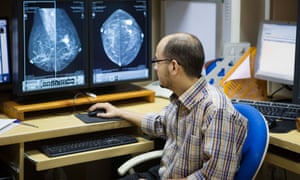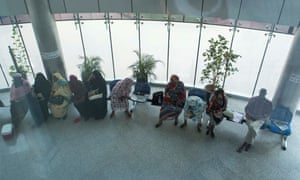The man sporting a giant purple bottom adorned with a swinging horse tail is chanting to the beat of the drummers, his blue-painted face sweating copiously. Children delightedly race around the colourful clown. All except Ismail, 13, who watches from the ground, twisting his head to follow the dance. A man with a megaphone is yelling something, but it can’t be heard in the melee. Then a group of blue-caped women emerge from the crowd, clutching cheap market stall lunchboxes, to begin the real business of the day.
This is the “flag-off” in Ungogo, Kano state. The party marks the first of four days of intense work by an army of volunteers, mostly young mothers, who will go door to door across Nigeria. Some will pass through thousands of twisting warrens of slums fanning out into the red-orange, mud-built hamlets and reed-thatched huts. Others will visit the crumbling concrete city blocks, slipping drops of polio vaccine into as many of the 30 million Nigerian children under five as they can find.
Their capes bear the slogan: “Lafiyar al’ummarmu hakkin kowa da kowa ne” – “The health of the child is the responsibilty of all.” The lunchboxes are filled with ice and polio vaccine. They have marker pens to dab on the finger of each treated child and chalk to mark every house wall they visit, marking which child was vaccinated and when. No one is to be missed out.
Ismail has mixed feelings as he watches, his useless legs tucked under him in the dust. He contracted polio aged two. “I blame my parents,” he says, “for not having me vaccinated, it makes me angry with them. I don’t feel so glad to see this today, I feel sad.”
Polio is a plague on the poor, a paralysing, disabling brute of a virus, it deforms the limbs and wastes the muscles. Children under five are most at risk and places with poor sanitation are favoured feeding grounds for the virus, which spreads through infected faeces. For every one person paralysed by polio, another 200 will be contagious.
Even in countries like the UK, where it has long been wiped out, sewers are regularly tested to ensure that polio does not sneak back into the population. Only three host countries remain: Nigeria, Afghanistan and Pakistan. Nigeria was on track to be declared polio-free in 2017. But just as it was ready to celebrate, the disease returned.

The stumbling block here is not a lack of effort. The drive to vaccinate by Nigeria, with help from Unicef, which has been behind this mass mobilisation, has been heroic. The problem is Boko Haram.
This fearsome insurgency group holds a great swath of territory in north-east Nigeria, where it attempts to impose an extreme form of Islamic law and a hatred of the west. Violent and insular, Boko Haram also tries to seal people in its territory and keep vaccination teams, seen as a western influence, out. It is to this area that polio has returned, and the fear is that those fleeing their violence could bring the virus back into the wider country. The two polio cases discovered in August were children displaced from Maiduguri, capital of Boko Haram’s stronghold, Borno state.
Boko Haram is now weaker, but the poverty, propaganda and fear that brought them into being remain strong. The memory of the murder of two Kano vaccination teams four years ago is still fresh. “I was soaked in blood,” said Abbas Ibrahim Musa, in the village of Kauyen Alu. “It was a Friday, at 8.30am. I was preparing the vaccines. I heard a gunshot and raised my head and saw a man in the door holding a gun. I fell to the floor and heard ‘bang, bang’. Then ‘shoot them, shoot them’. There was the smell of petrol and they started to burn the place. I had bodies on top of me. Providence decreed I didn’t die that day. Three people died and three were injured. One had just finished her studies, one a bus conductor with one child and a pregnant wife. One sold vegetables.”
Meanwhile, in a nearby village, other gunmen were slaughtering eight women, another team of volunteers. Three days before, a radio show had run an item in which an imam repeated allegations that the polio vaccine was a western plot to sterilise Muslims.
“I can say this,” said Musa. “Without Boko Haram polio would be a thing of the past. Some say health is not the problem; security is. They are linked. If we hear one child in Maiduguri has polio, then that means there are 200. So what if there are 10 children there? And very many children are coming out of the conflict zone. We don’t know, so we have to work harder. We persuade people by educating them. You make them understand. We have reduced the non-compliance rate here now to almost zero. I tell our workers ‘your names are written in gold’.”
But with some religious leaders sharing the distrust, what should have been a celebration of a disease eradicated is now a renewed struggle to finish a job that should have been over. Since the outbreak in Boko Haram-controlled territory, northern Nigeria has been in emergency mode. Teams of vaccinators are out almost constantly. “I almost cried,” said Rhoda Samson, “but not to finish the job is not acceptable.”
A supervisor in the mobilisation teams, Samson is thorough, checking every move her teams make. They visit a woman whose five-day-old baby still has no name. The chalk on the wall outside shows a list of visits here. “Seven times they have said no,” said Samson as her team coo over the baby. “Bamaso,” said the mother, Amina Ali. “We don’t want. My husband says vaccine is not food, why do the government not give us food? He refused and has not offended God.”
At this her husband, Ali Zaki, returns home, angry at the invasion of his house: “I believe God will provide; this is what we are taught.” But he is no match for Samson: “You think God doesn’t make the medicines? You want your children to have polio? To never play? Does Allah want that? What kind of man are you?”
When Zaki grudgingly agrees, the vaccine is quickly slipped into the baby’s mouth and the women clatter off, congratulating the couple. “They’ve a lot of reasons for refusing. We have some who don’t want drugs at all, some who say they won’t because they want something in return, some hear the stories,” said Samson. “The security situation is a problem. People are suspicious, they hear vaccinations make infertility. But we are bringing the numbers of non-compliants down; we will not stop.”
And they are not just fighting polio – they are creating a network and collecting data in a way never before done in Nigeria. A network of trained, community-based health workers, it’s a structure already being used to deliver other healthcare.
Senior state and government officials have recognised the value of this, gracing the polio flag-offs. In their elegant robes and themed hats, and long, often less elegant political speeches, their presence stresses to everyone in the fidgeting crowds of locals that something important is happening here. It is the kind of message that could reverse the damage done by Boko Haram, says Dr Kabiru Ibrahim Getso, Kano’s health commissioner. “Kano used to be a hub of polio cases, now it’s best practice. The last case was 2014 and this did not happen by accident. The teams are headed by the governor himself, it’s high profile This is how we do it. We go into the field every day, every day the volunteers are out there. Then we can use these structures to develop an entire primary healthcare system.”
Displaced people are especially targeted in this campaign. Abule Abdullah has hosted seven families – seven mothers and 33 children – in her home in Katsina state. One of her current guests is Aisha Idris, 40, recently arrived from Maiduguri.
“Boko Haram forced us to come here. The insurgency has stopped everything, the hospitals, the schools, everything is shut down,” she said. “My husband was killed at his Islamic reading group by a stray bullet from the fighting. My child was sick and so I came here with my children. I have to live with no roof over our heads but they have all been vaccinated now.” At the bus stations, and the state and national border crossings, the lunchbox-toting teams are there. Peering into cars, lifting the cloaks of women perched on motorbikes to find the babies strapped to their fronts and backs. Squeezing in the little vials of vaccine.
“If they say no, then we tell them they can go back,” said superintendent of immigration, Charles Tashllani, imposing order on Nigeria’s border with Niger in Katsina. Here, late in the evening, the Polio Emergency Operations committee reviews the campaign’s first day, which has seen 3,661 teams immunise 28,882 underfives. The detail is such that eight missing marker pens are on the agenda, as is the sacking of two town announcers who did not inform people about the programme.
“We look at every single child, everyone counts to us. I’m dealing with human beings. But we do have the iceberg phenomenon: many inaccessible, remote areas where we do not always know what is going on.
“People not feeling that polio is a threat to them, that is a big worry for a resurgence. But the biggest threat to health is Boko Haram. When we learned we had Borno refugees here in Katsina we were worried; they melt into the communities. It is potentially dangerous.”
The legacy of polio can be seen everywhere in Nigeria. Aminu Ahmen el-Wada lives with Hadza, his wife of 28 years, and those of their nine children who still live at home. One of life’s cheerful souls, he is enormously proud of the length of their marriage. “The trick is when I am the problem, I say sorry, when she is the problem, she says sorry,” says Wada.
The couple both skim along the floor using wooden handles Wada designed and carved to protect their hands – when your legs are withered from polio and are folded tiny and useless below your torso, your arms are the limbs that propel you. “I went to school until I became too heavy for my parents to carry me there,” said Wada. “So I taught myself to make hand-operated cycles, first for myself, then for others.” He now employs 20 people, 15 polio survivors. “Otherwise we would be beggars. This is because in Africa nobody can help you if you are disabled. But my father told me: ‘Disabled is in the body, not in the mind or in the heart,’ and this is what I believe.”
His smile falters only when he introduces Ummar, 14. His son contracted polio during a hiatus in the immunisation programme. “It was horrible. But the place behind our house is where people defecate. This is what happens.”
Wada began the Polio Survivors Group, which supports the vaccination drives. “I tell people: ‘Look at me. Do you want your child to end up like this? To never play football?’” Although he acknowledges the irony in that he also coaches a polio survivors’ para-football team. “But they would rather play for Arsenal,” he grins.
In his open-air workshop by the side of a main road in Fagge, the air smells poisonous as the men who would otherwise be beggars weld, cut and paint, making the three-wheeled, arm-operated cycles that give a certain freedom of movement. “This is the small size, for age five, then they can move up, age teenage, age adult,” he says. “One day I would like it that we make no more because polio is eradicated. Then we will make playground equipment instead, slides for happier children.”
He fires up his beaming smile: “Years ago in Nigeria we had leprosy, smallpox. We chased them all away. Now the last one is polio.”
Nigeria battles to beat polio and Boko Haram

